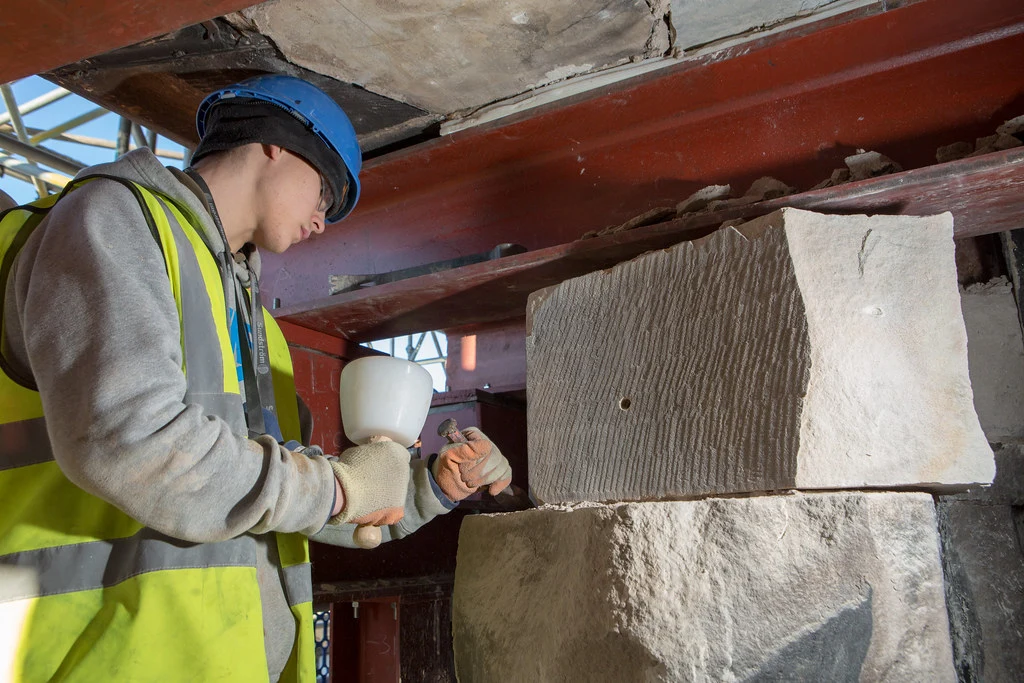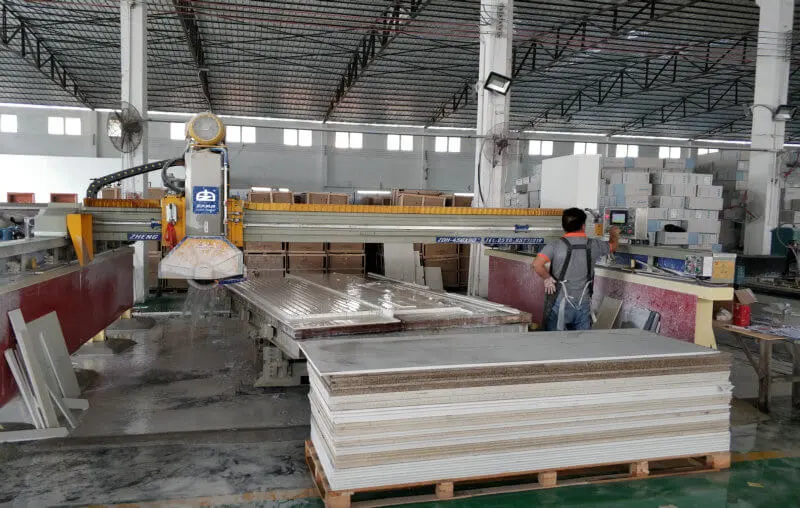Stonemasonry businesses across Australia are facing a significant shift in response to the ban on engineered stone, which will take effect in July 2024. This regulation, aimed at reducing health risks associated with silica dust, prompts these businesses to explore alternative materials and innovative practices. Companies are reassessing their product lines and supply chains to comply with new health and safety standards.
Businesses are not just adapting to these new norms but embracing them. Technology is playing a pivotal role in this transformation. By integrating digital tools and fabrication methods into their operations, businesses are enhancing efficiency and reducing reliance on materials now deemed hazardous. This transition is not just about compliance with the new legal framework; it’s about positioning these businesses for future growth in a rapidly evolving construction industry, where sustainability and safety are becoming paramount.
Key Takeaways
- Companies like Cosentino and Caesarstone are adapting to Australia’s engineered stone ban by developing safer materials and technologies, such as Cosentino’s HybriQ Technology and Caesarstone’s Breton technology, which comply with new safety standards.
- The engineered stone ban could significantly impact Australia’s stonemasonry industry, affecting up to 10,000 workers and prompting businesses to innovate and adopt alternative materials like sintered stone to ensure compliance and worker safety.
- To manage silica dust effectively and enhance safety, stonemasonry businesses are incorporating advanced technologies such as water-based cutting, LEV systems, on-tool extraction, and improved PPE, aligning with tighter regulations to protect worker health.
- The engineered stone ban in Australia has sparked significant industry adaptation, with stonemasonry businesses exploring safer, alternative materials and technologies to reduce health risks and ensure compliance with new safety regulations.
Effects on the Stone Businesses and Stonemasons

Image Source: flickr.com
According to the Australian Engineered Stone Advisory Group (AESAG) report, it is estimated there are between 750 to 1,000 fabrication companies/businesses in Australia. These entities are responsible for employing approximately 8,000 to 10,000 stonemasons. The recent ban on engineered stone due to concerns over silicosis risks associated with silica dust could have significant implications for this sector.
These businesses primarily rely on the cutting, grinding, and polishing engineered stone; the ban might force many to either shut down or shift their focus to alternative materials, leading to potential job losses and economic instability. Moreover, the need to retrain workers with new skills to handle different materials could impose additional financial strain on these companies. This disruption in the industry greatly impacted the livelihood of thousands of workers for retraining, material use, and financial considerations.
This challenges Australia’s broader construction and home renovation markets, potentially increasing costs and extending project timelines.
Businesses’ Response to Engineered Stone Ban

Image Source: opalyquartz.com
Companies that have solely worked with engineered stone face significant challenges due to Australia’s impending ban on this material, which will commence in July 2024. These companies are forced to quickly change their product line, creating new opportunities, and potentially introducing innovative materials to the mainstream market. Caesarstone and Cosentino, two major players in the engineered stone market, have responded differently to Australia’s impending ban on engineered stone, primarily due to the health risks associated with silica.
Caesarstone’s Response
Caesarstone has proactively started to shift its offerings in Australia to include alternative products that meet the upcoming regulations. They focus on supplying the Australian market with products that maintain their strong market presence while adapting to the new regulatory environment. This includes incorporating less hazardous materials than traditional engineered stone products.
Cosentino’s Response
Cosentino has actively engaged with stakeholders, including health ministers and industry regulators, to support adopting standards that enhance worker safety without compromising the construction and home-building sectors. They have successfully transitioned all their Silestone production to the new technology, and as of early 2023, all products distributed in Australia are in compliance with the new silica content standards.
Sintered Stone as an Alternative to Engineered Stone

Image Source: commons.wikimedia.org
The information gathered shows that the industry’s response to the ban varies. Some companies are exploring alternatives to engineered stone. For example, manufacturers like Neolith are shifting towards materials with lower or no crystalline silica content, introducing products like sintered stone, which has similar applications as engineered stone but contains much lower silica levels.
What is Sintered Stone?
Sintered stone is a manufactured material known for its durability and aesthetic qualities, making it popular for use in countertops, flooring, and wall cladding. Production involves compacting and sintering mineral raw materials (like quartz, feldspar, and clay) under high temperatures at 1,200ºC and pressures of 400 bars (5800 PSI). This process mimics natural stone formation but occurs over minutes rather than millennia.
Furthermore, it is available in various colours and patterns, some of which can closely mimic the look of natural stone, wood, or even concrete. Because of these properties, sintered stone is increasingly considered a more sustainable and safer alternative to materials like engineered stone, which can contain high levels of crystalline silica and pose health risks during cutting and installation.
Here’s a comparison of engineered stone and sintered stone:
| Feature | Engineered Stone | Sintered Stone |
| Applicability | Used for countertops, flooring, and wall cladding in kitchens and bathrooms due to its aesthetic appeal and durability. | Similarly used for countertops, flooring, wall panels, and facades due to its high durability and wide range of designs. |
| Health Risk Exposure | Contains crystalline silica, which can cause silicosis from dust inhalation when cut or processed without adequate safety measures. | Generally contains lower to no crystalline silica, reducing the risk of silicosis and making it safer for workers and installers. |
| Practicability | Requires specific cutting tools and safety measures to prevent silica dust exposure. It needs to be sealed to avoid stains. | Easier to maintain due to its non-porous nature, resistant to scratching, staining, and thermal shock. Does not generally require sealing. |
| Cost | It is generally less expensive than sintered stone, but the cost can vary based on quality and pattern. | Typically more expensive than engineered stone due to its manufacturing process and material properties, offering higher durability and less maintenance. |
Technological Advancements to Adapt to Engineered Stone Ban

Image Source: https://quantra.in
- Some companies utilizes the Breton technology in its manufacturing process. This system involves a highly automated, controlled environment that minimizes dust exposure while producing quartz surfaces.
- Various technologies are employed to manage silica dust in stone cutting: Water-based cutting suppresses dust by using water during the cutting process, Local Exhaust Ventilation (LEV) systems capture dust at the source, on-tool extraction attaches vacuums to tools to capture dust directly, and automated and remote-controlled equipment minimizes worker exposure. Additionally, advancements in Personal Protective Equipment (PPE) ensure workers are shielded from fine particles, enhancing safety and comfort.
Interested in how we can support your role as an employer? Click below to learn more.
Conclusion
As Australia approaches the ban on engineered stone in July 2024, stonemasonry businesses are pivoting towards innovative practices and safer materials to meet new health and safety standards. This transition is not merely a compliance issue but a significant opportunity for growth and innovation in an industry where sustainability and safety are becoming paramount.
At Dayjob Recruitment, we recognize the challenges and opportunities this transition presents to both job seekers and employers in the stonemasonry and broader construction sectors. Our role is to connect skilled professionals with innovative companies that are leading the way in safe and sustainable practices. Contact us today, and let us assist you in finding the right opportunities or talent that fits your needs.
FAQs
How does the transition to alternative materials like sintered stone impact the environmental footprint of stonemasonry businesses?
Transitioning to alternative materials, such as sintered stone, can reduce the environmental impact on stonemasonry businesses. Sintered stone is produced using natural minerals that are subjected to extreme heat and pressure, mimicking natural stone formation without extensive mining. This process typically consumes less energy than traditional stone quarrying and can utilize recycled materials, contributing to a more sustainable production cycle.
What training programs are recommended for stonemasons to adapt to working with new materials like sintered stone?
Stonemasons looking to adapt to new materials such as sintered stone should consider training programs that focus on the specific techniques required for cutting, finishing, and installing these materials. Programs offering advanced training in the latest fabrication technology, such as CNC machinery, and safety training related to dust management and modern installation methods will be crucial. Vocational schools and industry associations often provide these specialized training modules.
Are there financial aid options available for small stonemasonry businesses to help them transition to safer materials and technologies?
Small stonemasonry businesses may access various financial aid options to assist with their transition to safer materials and technologies. This could include government grants to enhance workplace safety, low-interest loans for purchasing new equipment, or tax incentives for businesses that invest in eco-friendly technologies. It’s advisable for business owners to consult local business support services or government websites for specific programs available in their region.
How can consumers ensure that the stone products they purchase are produced sustainably?
Consumers looking to ensure the stone products they purchase are sustainably produced should look for certifications that indicate environmentally friendly and safe production processes. Labels such as the Global Green tag or certifications from the Green Building Council can suggest that a product has been produced with a lower environmental impact. Additionally, engaging with suppliers to inquire about the origins of the materials and the manufacturing processes used can provide further assurance about the sustainability of the products.
Are you a job seeker looking for your next big opportunity? Click below to see how we can assist you in finding the perfect role.








